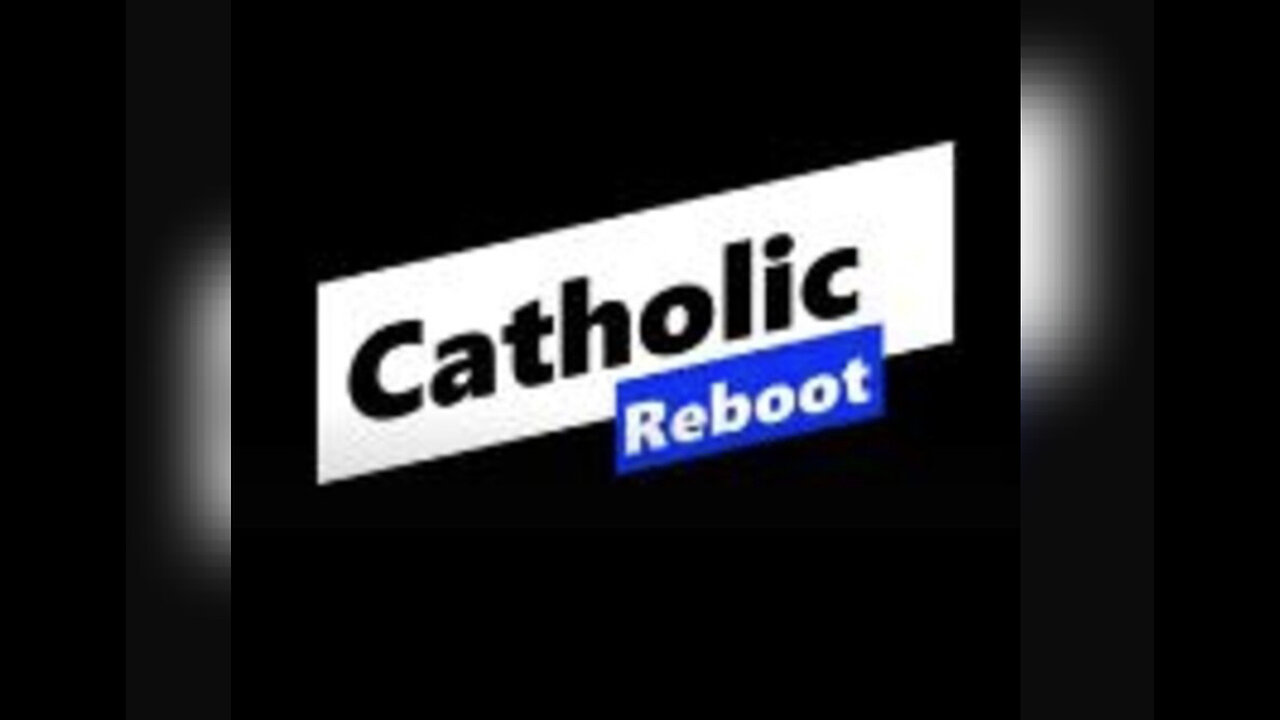Premium Only Content

Episode 994: The Blessed Candles of Candlemas
The Feast of the Purification of Our Lady on February 2, also known as Candlemas, was an important day that marked a turning point in the year for Catholic men of the past candlemas procession. The term Candlemas comes from the custom of blessing candles and having candlelit processions on this day. In the Middle Ages, the churches would be filled with lighted candles, creating a sort of fairy world of light to honor Our Lady. Even today, many traditional Catholic parishes preserve some of these old customs.
All of the candles to be used in the church in the coming year are blessed in a special ceremony with five prayers and the singing of the Asperges, followed by a candlelit procession. In the Middle Ages, this procession went into the churchyard past the graves of deceased parishioners offering prayers for their souls. After the procession, the Mass is said; during the Gospel and from the beginning of the Canon of the Mass to Communion the lighted candles are held by the faithful.
This procession is seen as a spiritual act of accompanying Our Lady, St. Joseph, Simeon and Anna in bringing Christ, the “light to the revelation of the Gentiles,” into the Temple. In his First Sermon On the Purification, St. Bernard says:
“The Procession of this solemnity was first made by these four, which afterwards was to be made, to the joy of the whole earth, in every place and by every nation. Let us not be surprised at its then being so little; for He whom they carried was little! Besides, all who were in it were just, and saints and perfect – there was not a single sinner!”
The faithful's use of blessed candles
In Eastern countries such as Syria and Chaldea, the sexton of the church would make the Candlemas candles of beeswax and paint them with gold. Catholics of Central and Eastern Europe decorated their handmade beeswax candles with flowers, holy images and other symbols.
The Polish made their long, thick Candlemas candles with beeswax and wicks of verbascum (a sacred Slavic herb). Before bringing the candles to the church, the women adorned the candles with evergreen twigs and light blue ribbons to symbolize Our Lady.
All Catholics used to have one blessed candle that accompanied them from Baptism until death. On Candlemas, if a new family member was expected, an extra candle would be blessed for that child. It would be their Baptismal, First Communion, Confirmation, marriage and death candle. This candle was kept by the Catholic throughout his whole life, even to the grave, where the candle was placed in the coffin. Some pious Catholics kept their blessed candle hanging over their bed as a reminder to be always ready for death.
Pious Catholics often brought multiple candles to church of different colors and sizes to be used for special purposes throughout the year. Easter, Christmas, All Saints and All Souls, being the most important feasts of the year, were honored by the presence of the bright flame of a blessed candle in many countries.
The Germans and Austrians attributed a special significance to the colors of their blessed candles. Colorful candles were used as "soul candles (or penny candles) to light for the deceased, black as weather candles to light as protection from the approaching storm, and yellow as Rosary candles, which were used on Saturdays for the Rosary." (Austrian Customs)
Many German peoples brought all of their handmade tallow candles needed for a farming year to the church to be blessed on Candlemas Day as well as wax candles for their home altars.
One charming German custom was the making of Wachsstöcke (intricately decorated wax tablets made of coiled sticks of wax) prior to Candlemas to be blessed with the other candles. These "wax sticks" were given to maids as a token of thanks and to brides before a wedding. (Austrian Customs) Holding blessed candles gave protection against wolves, storms and other maladies. Catholics believed that Our Lady protected those who carried blessed candles.
Candles for protection
Catholics all over the world lit blessed candles during storms to prevent lightning strikes, during times of sickness, during times of imminent peril on land or at sea, during difficult child births and at deathbeds. In Poland and Hungary, small pieces of blessed candles were burnt in the middle of fields to protect the whole property or buried under foundations of houses to protect the home.
On long journeys, Catholic men often brought blessed candles along for protection. Fishermen kept a blessed candle on their boat to light during stormy weather. Many Polish farmers started every major task of the year with a blessed candle in their hand (the first sowing of the year, leading the cattle out to pasture, the beginning and ending of harvest).
The Poles called Candlemas Day Święto Matki Boskiej Gromnicznej (The Feast of the Holy Mother of the Thunder Candle). The feast was so named, because the Polish peasants often invoked Our Lady under this title as the patroness of villagers and of people threatened by wolves. The Poles called the blessed candles gromnica ("thunder candles") because they were lit during storms. These candles were also lit in windows during the dark nights of winter to keep the wolves at bay.
Old Polish legends describe Our Lady walking through fields in the dark of winter carrying a candle to protect people from the wolves, to keep a watch over the crops and to light the way for weary travelers. Some Polish families kept a blessed candle burning by an image of Our Lady on Candlemas night to honor her and to implore her for protection from the wolves.
Many Catholic peoples safely guarded the flame of their candles lit at church during the procession, so that the blessed flame could be brought to the house. The French believed that " if someone could carry a Chandeleur candle all the way home from church without it going out, then that person would “certainly stay alive in the coming year.” (The Local)
In many other countries Catholics considered the task of preserving the candle flame to be essential for obtaining blessings in the year ahead.
Home ceremonies
In France and Poland, on arriving at his home on Candlemas Day, the head of the house marked a soot cross on the threshold of every doorway and window with the flame of the blessed candle. Any additional buildings on the property such as barns, stables, or sheds were blessed with incense and a small drop of the blessed wax. After this ceremony, the flame from the candle was used to light a fire of fir twigs at the hearth or stove.
A Polish fathers would mark a wooden beam in the house with the cross
The blessed candles were kept in a safe place, often tied to the wall with a ribbon and hung next to a holy image.
In German homes, the family prayed the Rosary together on the evening of Candlemas. In rural areas, the blessed candles were placed on a table together with “wax sticks” and “penny candles” for each of the deceased relatives. A few of the candles were tied to firewood shavings and lit along with one colorful “penny candle” for each member of the family who had died. On the holy water font by the door, several burning candles were placed for the salvation of those who came and went.
At the end of the Rosary, the leftover scorched shavings from the burned candles were made into crosses and hung in the stables to protect the cattle. These crosses were known as “Druden” candles because they protected people and animals from druden (night demons), who according to popular belief harmed animals and humans. The leftover wick was often eaten to protect those who ate it against throat diseases.
Restoring the customs
To our priests reading this article, we would like to unite our plea to that of Dom Guéranger, who urges a return to these good customs, especially in these modern times:
“It would be well if Pastors were to encourage this practice [of blessing candles and having Candlemas processions], retaining it where it exists or establishing it where it is not known.
window“There has been such a systematic effort made to destroy, or at least to impoverish, the exterior rites and practices of religion that we find, throughout the world, thousands of Catholics who have been insensibly made strangers to those admirable sentiments of faith, which the Church alone, in her Liturgy, can give to the body of the faithful.”
The Return of Light for Candlemas
At the beginning of February nature is characterized by a conflict between the dark nights of winter and the bright days of Spring. Since Christmas, the daylight has been shining for longer hours that increase every day. By Candlemas (February 2) the coming victory of the light over the darkness and the promise of Spring is manifest.
Winter & Spring meet on Candlemas
People of the past were carefully attentive to the changes in the natural world, and they placed great significance on the signs that nature gave during times of transition from one season to another. With the introduction of Christianity, the old pagan rituals and symbols gave way to Catholic customs that came from a true understanding of God's plan in creating the natural world.
Catholics understood that the victory of the daylight over the darkness at Candlemas was symbolic of Our Lord's victory over the Devil's reign. On Candlemas, the Church honors Our Lord through the words of holy Simeon as the "light to the revelation of the Gentiles."
Simeon's prophetic canticle of Our Lord's coming victory was reflected in nature's cycle. Just as the darkness of winter was losing its power over the world, so too was paganism and immorality approaching its demise with every day that the Christ Child grew older.
The sun's triumph reflected in people's customs
Austrian children attentively watched the sky on Candlemas Day to see if they could catch a glimpse of the sun breaking through the clouds of the dark winter sky to shed its rays upon the earth. When a ray was seen, the children sang a lovely song greeting the light:
sunrise
'O you bright sun, come, peek out
from behind the hills!'
Hail, glorious herald, holy light,
God sends you from His Heaven bright.
Your cheerful glow and golden rays
May bring us happy summer days.
Lead us through earthly toil and strife
To everlasting light and life.
On Candlemas evening, the children in some Russian villages sat near the outskirts of the town listening to legends told by the elders of the town. At dusk, they expectantly waited to see if the sun would peep from behind the mountain before sunset, which would denote the quick arrival of Spring. They sang a traditional song that began, "O you bright sun, come, peek out from behind the hills!"
In the Middle Ages, Candlemas was a "Quarter day" when servants and maids were paid for the year, accounts were settled, and tenants paid their rent. The landowners often invited their tenants along with their families to a grand banquet after the rent was paid. In Austria, the farm servants were given a feast prepared by the farmer's wife herself.
This day was also a traditional day to remove the cattle from the hay meadows and from the fields that were to be ploughed and sown in the Spring. Farmers began working outside again and preparing the fields for the first planting. Women set their spinning and knitting aside to attend to the outdoor chores.
Shoemakers and other artisans who worked indoors put away their candles on this day as the return of the light removed the need for candlelight until the darker days of Autumn. (4) Candlemas not only changed people's work customs, but also was the marker to determine the future weather. After Candlemas, a man could expect to either have another strong blast of Winter's frost and snow or sweet signs of the coming Spring.
In England, the people believed that the badger woke up from hibernation on this day and the weather determined whether he went back into his hole or remained above ground. If the badger saw his shadow due to sunny weather, he went back to sleep expecting a long winter.
The Germans used the same method to discover the upcoming weather, except that they replaced the badger with a hedgehog or, in some places, a bear.
Pennsylvanian man holding "Punxsutawney Phil"
German and English immigrants brought their Candlemas folklore to America. Since the groundhog was common in Pennsylvania and other areas where the Germans immigrated, they associated their lore about the hedgehog, badger, or bear with the groundhog. Hence, Midwestern farmers called this day "Ground-Hog Day."
The town of Punxsultawney, Pennsylvania even made an official town groundhog named "Punxsutawney Phil." For over 120 years, starting in 1887, people have been following the predictions of this groundhog. Even today, this groundhog is watched carefully as he leaves his den to see what his reaction will be and a festival is held in the town.
Catholics of the past not only observed the animals during this time of the year, but also the plants, many of which have deep symbolic meanings.
In the Middle Ages, the Snowdrop was known as the Candlemas Bells or the Purification Flower. The innocent medieval man believed that the Snowdrop, as an emblem of purity and virginity, blossomed on the day that Our Lady presented Our Lord in the Temple and that this flower has blossomed ever since on every Candlemas to honor Our Lady.
To honor this pious legend, people did not bring Snowdrops into their house before Candlemas. On that day, bunches of Snowdrops were collected and brought inside to purify the house. In Italy and other places in Europe, the image of Our Lady on the church altar was removed and replaced with Snowdrops which were strewn over it to symbolize the purity that Our Lady radiates wherever she goes. (7)
In addition to contemplating the symbolism in nature, Catholic peoples also prepared food that reflected the joy of the day.
In France, Belgium and Swiss Romany the people eat many special carnival treats on this day such as galettes, crêpes, beignets and cidre. Some people attribute the origin of this custom to Pope Gelasius I who provided for the pilgrims arriving in Rome by having pancakes prepared for them.
Crêpes are also symbolic of the sun, making them a fitting dish to commemorate the return of sunny days at Candlemas.
Farewell to Christmas
The change in the natural world reflects well the transition that Candlemas marks in the liturgical year. In the liturgical calendar, Candlemas is the last day of the Christmas season. In the past, many Catholics cherished every moment of the Christmas season, keeping up the joy and merriment of Christmas until the 40 days had come to an end.
Candlemas Day was the last day to sing traditional Christmas carols and also the day that Christmas decorations had to be removed. Although the traditional day to remove Christmas decorations and greenery was the Epiphany, some Catholic peoples of Europe, especially in Poland, Germany, Austria and England, kept their decorations up until February 2 because of their deep love for Christmas.
In most countries, even if other decorations were removed on the Epiphany, the crèche or Christ Child remained in a prominent place until Candlemas. In many French homes, the crèche was reverently put away on the afternoon or evening of Candlemas.
Christmas plants and greenery and the Yule log were also burned on Candlemas (if this was not already done on the Epiphany) as a last farewell to Christmas. The ashes were spread on fields and gardens to bring a successful harvest and protection against blight.
Some English farmers fed the Christmas greens to their cattle to protect them from disease. People saved sprigs of holly from the church or sprigs collected on Christmas Eve as efficacious means to protect themselves against demons and witches.
The task of removing the Christmas decorations was often performed with much solemnity. Many German families gathered around the crèche on the evening of this feast to pray the Rosary and sing their beloved carols before the Christ Child one last time. Each member of the family lit his blessed candle during the prayers.
In Mexico, the Christ Child (El Niño Dios) who has lain in the family crib since Christmas Eve is dressed in regal garments and carried to the church to be blessed after Mass. In doing this, the Mexicans unite with Our Lady in her journey to the Temple for the Presentation of Our Lord. On returning home, the Christ Child is seated on a chair or throne to represent the new focus from Our Lord's childhood to His adult life.
Families and friends then enjoy a fiesta featuring homemade tamales prepared by the host or hostess of the party. The person given this honor is the one who received the piece of the Rosca de Reyes (a circular sweet bread) in which the figurine of the Christ Child had been hidden on the feast of the Epiphany. (12)
In some places, the ceremony of saying farewell to the Christ Child was public. In the Italian city of Castelpoto, there was an ancient tradition of solemnly kissing the Child Jesus displayed at the high altar for one last time on Candlemas before he was ceremoniously removed to make way for the more somber adornments of Septuagesima.
All of these customs and symbols display a Catholic spirit that harmonically unites the natural season with the feasts of the Church. May we be given the grace to regain this spirit so that the meaning and symbolism of the Church's feasts may give us a new and more transcendent view of the world.
Even if the church you attend does not have a procession, it would be good to have a candlelit procession using blessed candles with your own family or community to honor Our Lady and Our Lord. Those candles can be used in all of the important events of the year, as well as during times of adversity.
The Church offers so many rich blessings through her Sacramentals that we ought to avail ourselves of these benefits. These good Candlemas customs offer the faithful a means to give glory to God by honoring the coming of the true Light Whom our flickering flames represent.
-
 3:13:59
3:13:59
SilverFox
4 hours ago🔴LIVE - OBLIVION IS BETTER THAN SKYRIM NOW
24.7K1 -
 LIVE
LIVE
SpartakusLIVE
8 hours agoDuos w/ StevieT || Trios or Quads Later?!
151 watching -
 7:19:12
7:19:12
OhHiMark1776
9 hours ago🟢04-27-25 ||||| Halo Multiplayer Rumble: No. 13 ||||| Halo MCC (2019)
75.1K -
 2:12:28
2:12:28
TheSaltyCracker
7 hours agoThey Killed Her ReeEEEe Stream 04-27-25
144K289 -
 2:33:51
2:33:51
vivafrei
17 hours agoEp. 261: Criminal Judges ARRESTED! Election in Canada! Santos Sentenced! RFK Jr. & Autism & MORE!
187K129 -
 6:24:31
6:24:31
Amish Zaku
10 hours agoRumble Spartans "The One Year" Event
46.3K1 -

Illyes Jr Gaming
7 hours agoLaid Back Sunday Night Warzone Stream!
18.8K -
 1:51:18
1:51:18
Nerdrotic
9 hours ago $6.91 earnedDiscoveries From Graham Hancock's "Fight for the Past" | Forbidden Frontier 099
48.4K12 -
 1:09:42
1:09:42
Sarah Westall
8 hours agoHidden Tech Resembles Star Trek: Malaysian Airline, Portals & Wormholes w/ Ashton Forbes
56.4K22 -
 1:13:46
1:13:46
Josh Pate's College Football Show
8 hours ago $1.92 earnedCFB Truth About NFL Draft | Sheduer & Ewers Slide | James Franklin vs Fans | 2025’s Biggest What-Ifs
22K5